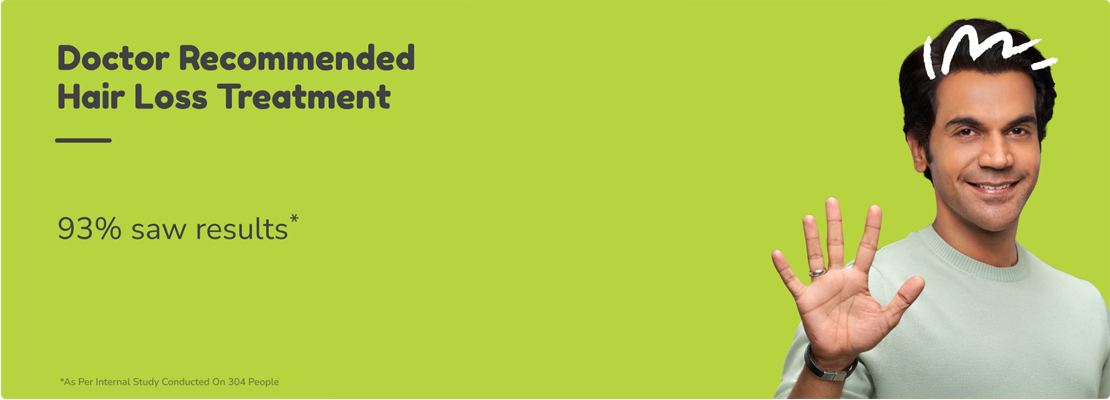Hair loss between 50 to 100 per day is normal. It can be temporary or permanent. But losing more than that can be a sign of baldness, an infection, or something more serious, such as an internal health condition. Suffering from too much hair loss is abnormal, and it's time to see a doctor. Especially if you feel any pain or rash on your scalp. These symptoms could bring serious health issues and need treatment.
How Much Hair fall is normal?
Most of us experience hair shedding almost every day. We shed 50 to 150 hairs daily. Hair grows and then falls out - it’s a cycle. So it is very much normal to expect some shedding.
The time from when hair starts growing, it takes about two to seven years to grow completely. The hair transition phase is the next step in the hair growth cycle and can last for about two weeks, then comes the resting phase lasting for a maximum of three months, and finally, this cycle ends in hair shedding. But, there is a difference between hair shedding and losing hair. Let's quickly see how is it different.
Hair fall vs Hair shedding
|
Abnormal |
Normal |
|
Losing hair count is more than 150 |
Losing hair count ranges between 50 to 100 |
|
Affects the total health of the body |
Does not have any effect on other body parts |
|
There is a need for an expert consultation |
Can be treated at home |
|
The cause of losing hair can be genetic, hormonal, and many more. |
Natural problem |
Could Hair Fall be Temporary?
Yes, hair fall can be temporary. There are many reasons for hair fall. Let us look into some temporary problems.
Cause of losing hair temporarily: You can control your losing hair problem and promote regrowth. The only things you have to know are the causes of temporary hair loss and ways to avoid them.
- Tight hairstyles like braids, ponytails, cornrows can damage your hair and cause hair breakage and hair loss. Change your hairstyles regularly. It can prevent thinning.
- Dramatic body changes such as rapid weight loss, giving birth, surgery, or any certain illness cause hair loss. It happens in the resting phase, and hair should grow back over time.
- In the growth phase, some drugs, radiation, and chemotherapy treatments can cause sudden hair loss. Unless the hair follicle gets damaged, these are temporary issues and will be recovered over time.
- Also, if you are not getting enough vitamin B12 and iron, you will start losing hair.
Reasons for hair loss permanently could result in scalp injury or can be a genetic issue. Let's move on to see some warning signs of hair loss.
Warning Signs of Excessive Hair loss
Hair loss does not need treatment most of the time, except for cosmetic purposes. But you should call your doctor if you are losing hair excessively. Here are some of the symptoms when you need to take action:-
- Losing hair too much.
- Unexplained or sudden hair loss.
- Losing hair with pain, itching, or redness.
- Losing hair with other symptoms, such as fatigue, swelling, heavy menstrual bleeding, and lymph nodes.
- Any drug-related hair loss.
Hair loss affects your ability to enjoy life. Hence, there is a need for treatments when you are experiencing excessive hair loss.
The best treatment for losing hair: In most cases of losing hair are treatable at home. Here are some options you can try out:-
- Scalp massage: Perhaps the cheapest method of getting rid of losing hair problems and getting thicker hair is a scalp massage. There are no side effects and it doesn't cost anything. During your hair wash time, gently massage your scalp to encourage blood flow. Or apply a hot oil massage before 30min of your hair wash time.
- Essential Oils: These oils are liquids derived from certain plants, and they’re primarily used in aromatherapy and other types of medicine. Traya’s Herbal hair oil has been used with success by some people with pattern baldness. This oil is an effective combination of Ylang-Ylang, Motia rosha, and camphor mixed with goat’s milk.
- Anti-thinning shampoo: Such products provide hair volume, so it looks thicker. This can be helpful for people with thin hair. Traya’s sulfate and paraben-free Hair fall shampoo contain powerful ingredients like niacinamide, biotin, and pea sprout extracts that promise a clear and healthier scalp to generate more hair growth.
- Multivitamins: Healthy hair depends on your food habit. With certain eating disorders, or malnutrition new hair may fail to generate from follicles. Your one blood test can help to know if you’re deficient in any nutritive components. If your nutrition level is low in several key areas, your doctor might recommend a daily multivitamin. Healthy hair needs folic acid, zinc, and iron to keep growing strong and thick hair. Improve your hair health with Traya’s Hair Vitamins with natural DHT blockers & multivitamins.
Dosage- 1 tablet daily or as the doctor prescribes.
- Minoxidil: Minoxidil is a hair loss treatment approved by the U.S. Food and Drug Administration (FDA), best known as its brand-name Rogaine. This is one of the best treatments for losing hair. If you apply it directly to the scalp twice a day, you may see thicker hair in balding spots. According to Traya, it will take an average of 5 to 6 months to see visible results. Traya has Minoxidil 5% for men and Minoxidil 2% for women without any side effects.
- Omega-3 and omega-6 fatty acids: Omega-3 and omega-6 fatty acids are called essential fatty acids. This is because the human body can’t make these acids. Omega-3 helps you to fight inflammation, which can cause premature hair loss. Omega-6, on the other hand, is good for the scalp. Omega-6 comes from plant-based oils, and omega-3 fatty acids are found in fish.
When to See A Doctor?
If you’ve noticed a lot of hair falling out when you comb or shampoo your hair, your hair begins to thin or your hairline starts to recede, one of the most important things you can do in stopping any further hair loss is getting in touch with an experienced hair care doctor.
You can start losing hair in your teenage time, as some men start suffering from baldness in their 20s or 30s. But how to identify initially that you are suffering from baldness? One easy method of knowing that if you are losing hair is by comparing the pictures that you have taken a few years back. You can see the visual differences between your hairline and hair thickness. If you notice any negative differences, contact an expert doctor. With baldness, the earlier you seek treatment, the thicker hair you’ll have. Take our Traya Hair test to know your hair loss problems. Get an appointment.
We are not just doctor-backed, we are doctor-prescribed.
FAQ's
It is normal to shed 50 to 100 hairs every day. But when you start losing hair more than that, and no home remedies are working then it’s time to visit a doctor.
Doctors are the experts in diagnosing and treating all hair-related problems like hair loss. Only a doctor can tell you the root causes of your hair loss problem. So you must consult a doctor if your hair is falling out.
Always make an appointment to see a Dermatologist. Hair problems start from the skin. And a Dermatologist is an expert doctor who specializes in skin.
If you see these signs given below, that suggests your hair loss could be more serious.
- You are losing eyelash or eyebrow hair.
- Muscles ache.
- Nails feel brittle.
- You are taking blood pressure or high cholesterol medication for it.
- Bad scalp itching.



